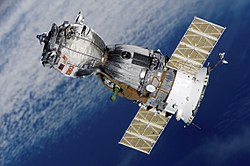 Soyuz 7K-MF6 and crew on a Soviet stamp | |
| Manufacturer | Experimental Design Bureau (OKB-1) |
|---|---|
| Country of origin | Soviet Union |
| Operator | Soviet space program |
| Applications | Crewed spacecraft as Earth Observatory Station |
| Specifications | |
| Launch mass | 6,510 kilograms (14,350 lb) [1] |
| Dimensions |
|
| Power | Solar arrays output 1.3 kW from 10 square metres (110 sq ft) on 4-segments |
| Equipment | MF6 multispectral camera |
| Regime | Low Earth orbit |
| Design life | Up to 35 days, used for 8 days |
| Production | |
| Status | Out of service |
| Built | 1 |
| Launched | 1 |
| Related spacecraft | |
| Derived from | Soyuz 7K-TM Soyuz 7K-T |
 Vimpel Diamond for entrainment patch | |
Soyuz 7K-MF6 is a version of the Soyuz spacecraft and was the second Soviet spacecraft designed for space station flight, a dedicated science mission. Its only crewed flight was conducted in 1976 with Soyuz 22 of the Soyuz programme. [2]


